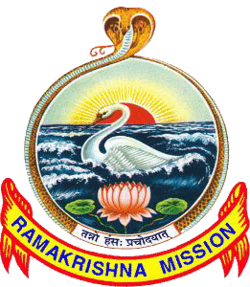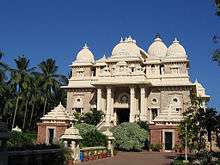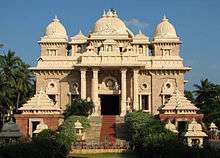Sri Ramakrishna Math, Chennai
Sri Ramakrishna Math, Chennai is a monastic organisation for men brought into existence by Ramakrishna (1836–1886), a 19th-century saint of Bengal. The motto of the Ramakrishna Math and Ramakrishna Mission is: "For one's own salvation, and for the welfare of the world".[1] The mutt in Chennai is the first branch center of the Ramakrishna Order in Southern India. It was started in the year 1897 by Swami Ramakrishnananda, one of the direct disciples of Ramakrishna. Besides Swami Ramakrishnananda, the Math was visited by Holy Mother Sri Sarada Devi, Swami Brahmananda, Swami Nirmalananda,[2] Swami Shivananda, Swami Abhedananda, Swami Premananda, Swami Niranjanananda, Swami Trigunatitananda, and Swami Vijnanananda.[3]
| Sri Ramakrishna Math ஸ்ரீராமகிருஷ்ண மடம் | |
|---|---|
 | |
| Religion | |
| Affiliation | Hinduism |
| District | Chennai |
| Deity | Sri Ramakrishna |
| Location | |
| Location | Mylapore, Chennai |
| State | Tamil Nadu |
| Country | India |
| Geographic coordinates | 13°1′51″N 80°16′2″E |
| Architecture | |
| Type | Fusion of Hindu, Islamic, Buddhist, Rajput, Christian styles |
| Creator | Ramakrishna Mission |
| Completed | 2000 |
| Website | |
| www | |

History
Origin
In February 1897, Swami Vivekananda returned to Calcutta from the West. At Madras, when devotees requested Swamiji to start a permanent center, Swamiji had said, 'I shall send you one who is more orthodox than the most orthodox Brahmins of the South and who is at the same time incomparable in performing worship, scriptural knowledge and meditation on God.'[4] He meant Swami Ramakrishnananda, who was sent in March 1897.
Ice House the First Monastery
The Ice House (now Vivekanandar Illam), otherwise known as Castle Kernan and situated in the Triplicane sea-beach, is a three-storeyed structure owned then by a prosperous advocate, Sri Biligiri Iyengar. It was there that Swami Vivekananda had stayed on his return from the West when he was given a historic reception by the citizens of Madras. Sri Iyengar who was a good devotee, now placed the ground floor at the Swami's disposal. Swami Ramakrishnananda moved to Ice House and started his activities. He set up a shrine for Sri Ramakrishna and would do regular worship there. While at the Ice House, Swami Ramakrishnananda started an orphanage for the destitute children which has now grown into a large institution called Ramakrishna Mission Students Home, Mylapore.[5] The Ice House served as the first monastery of the Ramakrishna Movement in South India for 9 years.[6]
Sri Ramakrishna Math in 1907
Biligiri Iyengar, the owner of the Ice House, died in 1902. Owing to financial problems the proprietors of the Ice House building decided to auction it in 1906. After the Ice House was sold out, Swami Ramakrishnananda shifted to an outhouse in the rear portion of the Ice House. He spent almost a year in that small room, until the new Math building was built at Mylapore, on a piece of land donated by a devotee. The Swami moved into the new building on 17 November 1907. This Math building constructed by Swami Ramakrishnananda no longer exists. It was unfortunate that within 2 years after its construction, extensive cracks developed in the roof of the building. One of the cracks was above the Shrine Room, and when there was sudden rainfall one night, Swami Ramakrishnananda held an umbrella over the Master's photo in the Shrine for the whole night. Soon after Swami Ramakrishnananda left Madras and Swami Sharvananda took charge in 1912, this building was demolished and the present two-storeyed building with a spacious front hall was constructed by 1917.[7]
Sri Ramakrishna Math 1917 – 2000
Swami Brahmananda, the first president of the Ramakrishna Order and a Direct Disciple of Sri Ramakrishna, who had come on his second visit to Madras laid the foundation stone for the new Math building on 4 August 1916. Thanks to the able supervision of Sri A. Ramalinga Iyer, superintending Engineer, the construction work progressed rapidly and on 27 April 1917, 8 months later, the inauguration ceremony was performed by Swami Brahmananda himself. At his instance the building was dedicated to Swami Ramakrishnananda, who died in 1911 in Calcutta.
Swami Brahmananda stayed in this building in a room to the Southeast on the ground floor. He used to walk inside the prayer Hall often touching the black stone pillars, going into high spiritual moods on several occasions.
Initially the building consisted of the large hall and a few rooms only on the ground floor. Later some rooms were built on the first floor, running parallel to the either side of the prayer hall. The shrine was located upstairs but there was no partition between the altar of Sri Guru Mahraj and the meditation room in which the devotees sat. The devotees literally sat at the feet of Sri Guru Maharaj. As this was felt inconvenient for conducting the worship, in 1938, some modifications were made in the shrine area which was moved back by a few feet and separated by bars from the meditation area. This provided much needed space both for conducting the Puja and other services at the altar and for accommodating the devotees (with seating capacity of 40) in front. A small gopuram was also added later. On the southern side of the shrine, one room was used as shayana griha for Sri Guru Maharaj and the adjoining room had large portraits of Holy Mother Sri Sarada Devi, Swami Vivekananda, Swami Brahmananda and Swami Ramakrishnananda.
The prayer hall in the Old Temple was a witness to many important events. Besides conducting a regular worship for 80 – plus years (except for a short period during the Second World War in 1942, when due to the fear of the bomb threat, from the Japanese forces, the puja to the sacred relics of Sri Ramakrishna was briefly shifted to Uttiramerur), the shrine has been a place of many spiritual and cultural events. All the seva (ritual-service) to Sri Ramakrishna were done here as per the norms and procedures laid by Swami Ramakrishnananda. Swami Brahmananda ordained Swami Yatiswarananda into Sannyasa in this shrine. Swami Vireswarananda, the 10th president of the Order, was invested with brahmacharya vows here. Three other Direct Disciples of Ramakrishna Swami Shivananda (3rd president of the Ramakrishna Order), Swami Nirmalananda and Swami Vijnanananda (5th president of the Ramakrishna Order) – also stayed in this building during their visits. Several eminent monks of the order such as Swami Ashokananda, Swami Prabhavananda, Swami Akhilananda and many others have lived and performed intense spiritual practices in this building.
With a seating capacity of 300, the main hall was the place where most weekly and Jayanthi day discourses were held for several decades. This was the main hall for all important pujas, public meetings and celebrations till 1963. In the year 1920/21, Durga puja was conducted here. For this purpose at the behest of Swami Brahmananda, Ramlal Chattopaddhyaya, the nephew of Sri Ramakrishna, brought the image of Mother Durga from Calcutta. Durga puja in image was held here again in 1952, 1953 and 1954. The centenary celebrations of Sri Ramakrishna (1936), Holy Mother Sri Sarada Devi (1953) and Swami Vivekananda (1963) were held in this hall. Many National leaders such as C. Rajagopalachari, Morarji Desai, K. Kamaraj and others have spoken on various occasions. On the occasion of 150th birthday celebration of Holy Mother Sri Sarada Devi, fibre glass statue of the Holy Mother was placed here in 2004 – after taking it around in a procession in various parts of Tamil Nadu

Since the year 2000, after the new Universal Temple of Sri Ramakrishna was consecrated in the same premises in the site adjacent to the library, the Old Temple is used for meditation, occasional classes and meetings for students and devotees.[8]
The Universal Temple 2000 onwards
Sri Ramakrishna Math completed 100 years of its service in 1997. The shrine of Sri Ramakrishna set up in 1917 was too small to accommodate the growing number of devotees. The idea of universal temple was conceived and Swami Bhuteshanandaji Maharaj, the 12th president of Ramakrishna Math and Ramakrishna Mission, laid the foundation stone for the Universal Temple on 1 December 1994, and realized by the temple architect G Venkataramana Reddy. On 7 February 2000 the temple was dedicated by Swami Ranganathananda, the 13th president of the Ramakrishna Order.[9]
After Swami Ramakrishnananda, the monastery was headed by Swami Sharvananda (1911–26), Swami Yatiswarananda (1926–33), Swami Saswatananda (1936–44), Swami Kailasananda (1944–71), Swami Tapasyananda (1971–91), and Swami Smaranananda (1991–95). The present head, from 1995 is Swami Gautamananda.
Activities
Celebrations
The Birthdays (according to tithi) of Sri Ramakrishna, Sri Sarada Devi, Swami Vivekananda and Swami Ramakrishnananda are celebrated in a grand manner every year. The Birthdays of Gautama Buddha, Jesus Christ, Sri Sankara, Sri Ramanuja and Sri Chaitanya are also celebrated every year. The birthday celebrations are marked with special Puja, Homa, Chanting, Bhajans, Musical programmes and Lectures. Special puja is also performed on Guru Purnima, Rama Navami, Ganesh Puja, Shivratri, Krishna Janmashtami, Navaratri, Kali Puja, Durga Puja, Lakshmi Puja, Saraswati Puja and other auspicious days.[10] As part of the National youth day celebrations, this year All India level Short film contest has been announced.[11]
Publication
The Madras Math is today the largest publication house of the Ramakrishna Order. The Math currently publishes 292 titles in English, 333 in Tamil and 17 in Sanskrit/English[12]
The Math published its first major book – Swami Vivekananda's Inspired Talks, in 1909. In the same year was published Swami Ramakrishnananda's Universe and Man. In 1909 came his next book Krishna: Pastoral and King-maker followed by The Soul of Man in 1910.
In 1912 was published a translation of the first volume of the Bengali Sri Sri Ramakrishna Kathamrita under the title The Gospel of Sri Ramakrishna. About a decade later Swami Ashokananda translated the second volume. Swami Sharvananda translated eight principal Upanishads and the series become most popular. In 1920 he translated the first part of Swami Saradananda's Sri Sri Ramakrishna Leeelaprasanga. Its English title was Sri Ramakrishna, the Great Master (1952).
The complete text of the Gospel of Sri Ramakrishna, translated by Swami Nikhilananda was published in 1944 and of Sri Ramakrishna the Great Master, translated by Swami Jagadananda in 1952. Swami Tapasyananda translated into English a great many Sanskrit texts, including Srimad Bhagavata published in 4 volumes in the year 1980. Another of his books, The Bhakti Schools of Vedanta (1990), has been much acclaimed by scholars.
The Math publishes 2 monthly journals: The Vedanta Kesari in English and Sri Ramakrishna Vijayam in Tamil. The Vedanta Kesari was started in 1914 and has over the years built up a good reputation for its authenticity and scholarship. Sri Ramakrishna Vijayam, started in 1921, has today the largest circulation among religious journals in Tamil.
It is worth mentioning that the Telugu publication wing of the Ramakrishna Order was in Chennai since its inception till 2006 when it was transferred to Hyderabad, during which period all the Telugu books and the Telugu Monthly Sri Ramakrishna Prabha used to be published from Chennai.
Educational Work
The Math's educational activities were initiated by Swami Ramakrishnananda even during the Ice House days. Moved by the pitiable condition of a few boys who had lost all their relatives in plague epidemic, Swami Ramakrishnananda felt that something must be done for the relief and rehabilitation of this type of orphans. With the meager means at his command he had already given shelter in the Math to two orphan students. He exhorted two of his young and earnest devotees, Sri Ramaswami Iyengar and Sri Ramanujachari to take up the responsibility of running an orphanage. A humble beginning was made on 17 February 1905 with seven inmates housed in a small rented house on Kesavaperumal Southward street at Mylapore. Thanks to the dedicated labour of Ramu and Ramanuju, aided by a band of selfless workers and sympathetic public, the orphanage was soon able to take in more boys. It changed its quarters five times before shifting to a plot of land donated by Sri S.G. Srinivasachariar. The foundation stone for the new building was laid by Swami Brahmananda on 16 May 1917 and the orphanage moved to its new building in May 1921. In 1922 a residential high school was started so that the orphans could study within the campus itself.
Swami Ramakrishnananda was also the inspiration behind the National Girls School, George Town. The Math took over its management in 1921. In 1932 a school for boys was started at T.Nagar. The Girls High School, Sri Sarada Vidyalaya, at T.Nagar was taken over by the Math in 1938, and additional wings like an elementary school, a training school and hostels were incorporated. In June 1946 was started the Vivekananda College at Mylapore.
Since the educational activity has expanded enormously, the institutions have been divided into separate Ramakrishna Mission centres for facilitating efficient administration. Under the Madras Math's direct control there are at present:
Medical Service
- A charitable allopathic-cum-homeopathic dispensary with general, dental, eye, ENT, surgical, X-ray, ultrasound scanning, paediatrics, ECG, gynaecology, physiotherapy and laboratory sections, and clinics for TB and diabetes. About 220,000 cases are treated annually.[16]
- A weekly mobile medical unit, which treats 10,000 cases annually[17]
- Prevention of Disability (POD) and rehabilitation camps for 300 Leprosy Affected Persons (LAPS)
- Regular eye camps in nearby villages
Relief and Rehabilitation
The history of the Ramakrishna Order's relief services is as old as that of the Mission itself. Besides their multifarious permanent constructive works, from their very inception, the Ramakrishna Math and the Ramakrishna Mission have been ever ready to promptly organise ameliorative and healing services whenever the nation has been faced with sudden calamities caused by freaks of nature, follies of men, or scourges of epidemics. Its relief activities have also extended well beyond Indian borders.[18]
For the 1897 famine in Bengal, Swami Ramakrishnananda appealed for funds in the Brahmavadin and sent a substantial amount for the relief work. In 1928 and, twenty years later, in 1948, when some huts caught fire at Mylapore, the Math organised prompt aid and relief. The Math created a colony for the 100 affected families with the help of plot of land given by the Government. It was named Ramakrishnapuram.[19] The following are the major relief activities undertaken by the Math.
| Month/Year | Affected Villages/District | Relief Type |
|---|---|---|
| 1924 | Coimbatore, Bhavani, Sathyamangalam and Other districts | Flood relief |
| 1927 | Nellore | Cyclone relief |
| 1932 | Chengalpattu and Thanjavur | Flood relief |
| 1941 | Thanjavur District | Cyclone relief |
| 1955 | Thanjavur and Ramnad districts | Flood relief |
| 1957 | Ramnad district | Riots |
| Nov 1957 | Sulurpet in Nellore District | Flood relief |
| 1961 | Thirukattupalli and Thiruvaiyaru in Thanjavur District | Flood relief |
| 1962 | Lalgudi in Trichy | Fire relief |
| 1965 | Rameswaram and Dhanushkodi | Cyclone relief |
| 1972–73 | Bhavani in Coimbatore district | Flood relief |
| Nov 1977 | Thanjavur, Trichy and Pudukottai | Flood relief |
| Nov 1985 | Vyasarpadi, Triplicane, Velachery, Kotturpuram and Perambur | Flood relief |
| Jan 1993 | 8 Villages in Kanyakumari District | Flood relief |
| Sep 1993 | Puduveetuvilai, Keelmadichal & Kanchinagar villages in Kanyakumari District | Cyclone relief |
| Dec 1993 | 47 villages across Tamil Nadu | Cyclone relief |
| Dec 2004 – May 2005 | Chengalpattu, Chennai, Nagapattinam, Cuddalore, Kanchipuram, Villupuram and Kanyakumari District | tsunami relief[20] |
| 2008 | Thanjavur and Tiruvarur Districts | Flood relief[21] |
| 2010 | Tiruvarur and Nagapattinam Districts | Flood relief[22] |
Rural Development
- Sri Ramakrishna Math, with assistance from Direct-Relief International and GlaxoSmithKline runs a One Year Nurse Assistant Training programme. The programme was started in the year 2004 following the Indian Ocean tsunami.[23] A need was felt to empower the local young women of the tsunami affected districts. So far, 1200 nurses have graduated in the last four years and currently 300 girl students are undergoing training in various Nursing Training Institutions in Chennai.[24]
- The Math conducts free computer training courses for rural girls in Tiruvallur District.
Gallery
- Prayer Hall in Old Temple
References
- The Headquarters of Ramakrishna Math and Ramakrishna Mission, India. Belur Math.
- Swami Nirmalananda A Unique Disciple of Sri Ramakrishna
- Holy Mother, Swamiji and Direct Disciples at Madras, p iv
- Swami Ramakrishnananda A Portrait in Pictures, 2006, p.25
- Vivekanandar Illam The Storyline 60 facts about Vivekanandar Illam, p.14,15
- Vivekanandar Illam The Storyline 60 facts about Vivekanandar Illam, p.18
- Swami Tapasyananda, Swami Ramakrishnananda The Apostle of Sri Ramakrishna To the South, 2008, p.57,58
- Archived 9 September 2010 at the Wayback Machine
- Universal Temple, Its Need, Significance and Unique Features, 2001, p.1,2
- Celebrations. Chennaimath.Org (4 August 2013).
- http://www.chennaimath.org/ydc2015
- Publications of Ramakrishna Math and Ramakrishna Mission. Belurmath.org.
- Higher Secondary School. Chennaimath.Org (6 June 2008).
- Primary School. Chennaimath.Org (14 September 2012).
- Archived 22 February 2011 at the Wayback Machine
- Archived 15 July 2010 at the Wayback Machine
- Mobile Dispensary. Chennaimath.Org (4 August 2013).
- http://www.belurmath.org/relief_news_archives/relief.htm
- The Vedanta Kesari December 1997, Sri Ramakrishna Math, Chennai: A Brief History, p.480, 481 & 482
- Tsunai Relief And Tsunami Rehabilitation By Ramakrishna Mission. Belurmath.org.
- December : 2008 – RELIEF WORK BY RAMAKRISHNA MISSION, BELUR MATH, INDIA. Belurmath.org.
- Archived 20 July 2011 at the Wayback Machine
- https://web.archive.org/web/20101227172117/http://www.gsk.com/community/row-nursing-india.htm. Archived from the original on 27 December 2010. Retrieved 1 February 2011. Missing or empty
|title=(help) - Nursing Assistant Training. Chennaimath.Org (4 August 2013).
External links
| Wikimedia Commons has media related to Sri Ramakrishna Math, Chennai. |